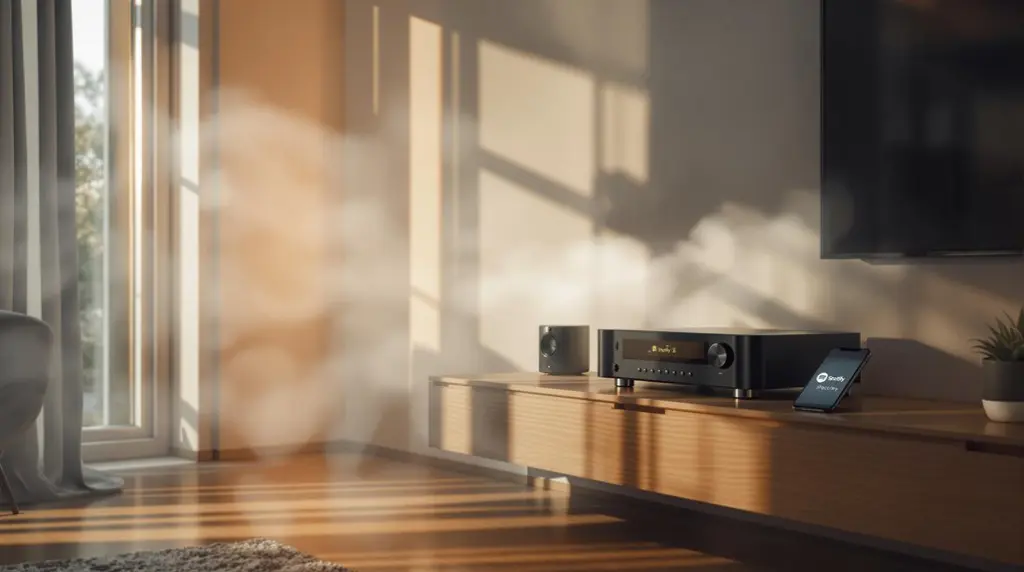DJ software is an essential tool for contemporary DJs, offering capabilities like beatmatching, looping, and real-time effects. Leading options such as Serato DJ, Traktor, and rekordbox provide sophisticated features including automatic track syncing and advanced effects. These programs analyze tracks for BPM and key, ensuring seamless shifts. Significantly, they offer robust library management and DVS compatibility, bridging traditional setups with digital workflows. Setting up requires ensuring your system meets minimum specifications and installing the software correctly. By mastering basic mixing techniques and utilizing advanced software functions, beginners can enhance their craft. Continue exploring to uncover deeper insights and industry trends.
Key Takeaways
- DJ software allows for mixing and manipulating digital music files with features like beatmatching, looping, and real-time effects.
- Popular DJ software includes Serato DJ, Traktor, and rekordbox, each offering unique functionalities and pricing.
- Key features to look for are deck management, track analysis, cue points, looping, and DVS compatibility.
- Ensure your laptop meets system requirements and follow installation instructions for proper setup.
- Regular practice and recording mixes are essential for continuous improvement and skill proficiency.
What Is DJ Software?
DJ software is an essential tool that revolutionizes how DJs mix and manipulate digital music files. The DJ software evolution has seen significant advancements, enabling DJs to seamlessly integrate digital music manipulation into their performances.
Tools such as beatmatching, looping, and real-time effects have transformed the art of DJing, allowing for more intricate and creative sets. With the advent of software like Serato DJ, Traktor, and rekordbox, DJs now have access to unique features, including automatic track syncing and advanced effects, which streamline their workflows and enhance their creative potential.
One of the critical aspects of modern DJ software is the ability to analyze tracks for BPM (beats per minute) and musical key. This facilitates smoother changes and harmonically coherent mixes, essential for maintaining the energy and flow of a live set.
In addition, many DJ controllers are bundled with free versions of popular DJ software, reducing the barrier to entry for beginners and fostering a new generation of digital DJs.
The industry trend towards subscription models, with prices starting around $9.99 per month, guarantees that users have access to the latest features and updates, keeping their performances at the cutting edge of technology.
The continuous evolution of DJ software underscores its pivotal role in the future of music manipulation and live performances.
Key Features to Look For
When selecting DJ software, it is imperative to prioritize certain key features that greatly enhance both performance and creativity. Deck management is essential; leading software like Traktor and Serato provide support for up to four decks, enabling DJs to mix more tracks simultaneously and explore creative possibilities. Track analysis capabilities are also fundamental, as they automatically determine BPM and key, facilitating seamless mixing and effective beatmatching.
Intuitive cue point and looping functionalities are important for live performance preparation, allowing DJs to set precise points in tracks and create seamless shifts. Additionally, an auto-mix feature, seen in software such as rekordbox DJ, can be invaluable for events, providing automated blending of tracks to guarantee smooth shifts without manual intervention. Compatibility with digital vinyl systems (DVS) is another significant feature, offering the tactile control of digital music files using traditional turntables, which is highly favored by many professional DJs.
Here is a comparison of key features across popular DJ software:
| Feature | Description | Example Software |
|---|---|---|
| Deck Management | Mix with multiple decks | Traktor, Serato |
| Track Analysis | Automatic BPM and key detection | Traktor, Serato |
| Cue Points & Looping | Set and loop points in tracks | rekordbox DJ, Serato |
| Auto-Mix | Automated track blending | rekordbox DJ |
| DVS Compatibility | Control digital files with traditional turntables | Serato, Traktor |
Popular DJ Software Options
When examining popular DJ software options, it’s essential to take into account key features such as advanced mixing capabilities and hardware compatibility.
Traktor Pro 2 and Serato DJ Pro, both priced at around $99, offer robust four-deck mixing, while rekordbox DJ’s seamless integration with Pioneer CDJs at $129 exemplifies the trend toward ecosystem optimization.
For those seeking budget-friendly alternatives, Serato DJ Lite and Mixxx provide essential functionalities, proving that quality tools are available at every price point.
Additionally, software like VirtualDJ and Djay Pro leverage AI-driven mixing and streaming service compatibility, making them versatile choices for DJs of all skill levels.
Key Features Overview
How does one navigate the myriad options available in the world of DJ software? Popular platforms like Traktor and Serato offer robust track organization features, enabling DJs to manage extensive music libraries efficiently.
Traktor’s advanced capabilities, such as automatic BPM detection and syncing across multiple decks, streamline the mixing process, guaranteeing harmonic consistency. Serato, on the other hand, is known for its user-friendly interface and frequent software updates, which keep it at the forefront of industry standards.
rekordbox DJ stands out with its seamless integration with Pioneer CDJs, an essential feature for professional DJs seeking reliability and performance. Its auto-mix functionality allows for effortless set creation, appealing to both novices and seasoned professionals.
Traktor Pro 2’s unique Stems deck feature offers unparalleled creative control by allowing manipulation of individual track elements, thereby fostering innovative mixing techniques.
For those seeking free alternatives, Serato DJ Lite and Mixxx provide fundamental DJing features without financial commitment. Mixxx, being open-source, is particularly attractive to Linux users, offering a full suite of DJ tools.
In a rapidly evolving industry, staying updated with the latest software updates guarantees DJs can leverage new features and enhancements, maintaining a competitive edge.
Compatibility and Integration
Compatibility and integration are pivotal elements that define the efficacy and appeal of DJ software in professional settings. Leading options such as Serato DJ, Traktor, and rekordbox demonstrate exceptional controller compatibility, interfacing seamlessly with a diverse array of DJ controllers and hardware. This guarantees that DJs can effortlessly integrate their software into live performances, leveraging advanced features and real-time responsiveness.
Serato DJ Lite, available for free, offers a gateway into the ecosystem, while Serato DJ Pro and Traktor Pro 2, each priced at $99, cater to serious DJs by providing a suite of sophisticated functionalities. Rekordbox DJ, priced at $129, is meticulously engineered for Pioneer CDJs, ensuring peak performance and unparalleled software integration in club environments.
Moreover, the support for Digital Vinyl Systems (DVS) in software like Traktor and Serato provides a bridge between traditional turntable setups and modern digital workflows. This feature is indispensable for DJs who prefer the tactile feedback of vinyl while accessing the extensive libraries of digital files.
Enhanced compatibility with various audio interfaces and MIDI controllers further augments the versatility of these software solutions, allowing for highly customized and dynamic setups tailored to individual performance needs.
Setting Up Your Software
Setting up DJ software is a pivotal step in guaranteeing a seamless and dynamic performance. To begin, confirm that your laptop meets the minimum system requirements. This typically includes a multi-core processor and at least 4GB of RAM to handle the software’s demands effectively. Having a user-friendly interface can also greatly enhance the setup process.
Next, initiate the installation process by downloading your chosen DJ software from an official website or authorized distributor. Follow the on-screen instructions meticulously and activate any necessary licenses to fully operationalize the software.
Once installed, connect your DJ controller or interface to your laptop via USB. Confirm that you have installed the correct drivers to enable seamless communication between your hardware and software. Proper configuration of the audio settings is essential. Select your audio interface as the primary sound output, adjust the buffer size to minimize latency, and set the appropriate input and output channels.
Lastly, organizing your music library within the software will streamline your sets. Import tracks, create playlists, and utilize tagging features to categorize your music by genre, BPM, and key.
- System Requirements: Confirm your hardware meets the minimum criteria.
- Installation Process: Download and install from official sources.
- Audio Configuration: Optimize settings for reduced latency and correct channel mapping.
Basic Mixing Techniques
In mastering basic mixing techniques, beatmatching and syncing are essential for aligning tempo and phase, ensuring a seamless auditory journey.
Equally critical, EQ and gain control allow DJs to balance and sculpt the sonic landscape, preventing distortion and maintaining a consistent volume.
These foundational skills are pivotal for creating dynamic and engaging sets that resonate with audiences.
Beatmatching and Syncing
Mastering the essentials of beatmatching and syncing is a fundamental skill for any aspiring DJ, facilitating smooth shifts and maintaining the energy of a set. Central to this process is the precise alignment of tempos and rhythmic patterns, guaranteeing seamless changes between tracks.
Effective track selection plays a significant role, as choosing songs with compatible BPMs and key signatures can simplify the beatmatching process. Modern DJ software enhances this by analyzing and displaying BPM and key data, providing visual cues that aid manual synchronizations.
Automatic syncing features in DJ software allow for a more creative approach, enabling DJs to focus on layering effects and complex mixing techniques rather than constant tempo adjustments. However, mastering manual beatmatching remains invaluable, especially for live performances where real-time adaptability is vital.
Regular practice is essential, with basic proficiency often achievable within hours to a few days. Here are some important aspects to keep in mind:
- Track Selection: Opt for tracks with complementary BPMs and rhythms to guarantee smoother changes.
- Visual Cues: Utilize software’s BPM and key analysis for more accurate beatmatching.
- Manual vs. Automatic Sync: Balance the use of automatic sync with manual beatmatching skills to maintain versatility.
EQ and Gain Control
Achieving a polished mix hinges on the adept use of EQ and gain control, foundational elements in the DJ’s toolkit. Gain control adjusts the input level of each audio source, ensuring audio consistency across all tracks and preventing distortion. This meticulous calibration is essential for maintaining balance and preventing any track from overpowering the mix.
Equalization (EQ) is the art of frequency manipulation, allowing DJs to sculpt the sonic landscape by boosting or cutting specific frequency ranges such as bass, mid, and treble. A typical EQ setup on a mixer includes three bands: low, mid, and high. Effective use of EQ can eliminate muddiness by cutting low frequencies from tracks that don’t demand them, thereby enhancing clarity and definition.
Mastery of gain and EQ is paramount for professional-sounding mixes, directly influencing the energy and clarity of a DJ’s performance. Below is a table summarizing key aspects of EQ and gain control:
| Control | Function | Impact |
|---|---|---|
| Gain | Adjusts input level | Prevents distortion, balances volume |
| Low EQ | Controls bass frequencies | Enhances depth, reduces muddiness |
| Mid EQ | Modifies vocal and instrument ranges | Clarifies and balances mids |
| High EQ | Adjusts cymbals and hi-hats | Adds brightness, reduces harshness |
| Master EQ | Overall frequency manipulation | Shapes the final sound output |
Understanding these principles is essential for any aspiring DJ, paving the way for seamless and dynamic performances.
Advanced Software Functions
While the fundamentals of DJing remain rooted in creativity and musicality, advanced DJ software functions have revolutionized the craft by offering sophisticated tools that enhance performance capabilities.
Central to this evolution is track manipulation, which allows DJs to dissect and reconstruct musical elements with precision. For instance, software like Traktor’s Stems deck functionality enables creative mixing by isolating and blending individual components such as vocals and instruments.
Advanced features include:
- Beatmatching: This function automatically aligns the tempo of two tracks, facilitating seamless changes and maintaining the dance floor’s momentum.
- Track Analysis: Thorough tools analyze BPM and musical key, aiding DJs in selecting harmonically compatible tracks, thereby ensuring smooth and sonically pleasing mixes.
- Dynamic Effects: Techniques like looping, slicing, and sample triggering empower DJs to infuse their sets with unique soundscapes, adding an element of unpredictability and excitement.
Moreover, industry trends show a growing preference for automated systems like rekordbox DJ’s Auto-Mix feature, which selects and blends tracks autonomously, offering DJs more freedom to focus on other aspects of their performance.
These advanced functions collectively push the boundaries of what is possible in live DJing, providing a robust platform for artistic innovation.
Tips for Continuous Improvement
Continuous improvement is essential for any DJ aspiring to refine their craft and stay ahead in the dynamic music industry. One of the most effective strategies is to regularly record and review your mixes. This practice allows you to objectively identify areas for improvement and track your progress over time.
Leveraging mixing feedback from peers and experienced DJs can provide invaluable insights. Joining online DJ communities and forums offers a platform to share your mixes and receive constructive criticism, enhancing your technical skills and artistic vision.
Creative experimentation with different genres and mixing techniques is critical for broadening your skill set. This not only enhances your versatility but also fosters innovation in your performances.
Attend live DJ events to observe professional DJs; their techniques and audience engagement strategies can offer new perspectives and inspire your own practice.
Setting specific practice goals, such as mastering a new software feature or technique, can maintain your motivation and focus on continuous improvement. By systematically tackling these goals, you guarantee a structured and progressive enhancement of your skills.
In a rapidly evolving industry, staying updated with industry trends and continuously honing your abilities is essential for sustained success.
Frequently Asked Questions
How to Start DJING as a Beginner?
To start DJing as a beginner, invest in essential DJing equipment like a controller and mixer. Master fundamental mixing techniques such as beatmatching and EQ adjustments. Leverage online resources and tutorials to stay updated with industry trends and creative insights.
What Software Do You Need to Start DJING?
To start DJing, consider DJ software comparisons like Traktor, Serato DJ, and rekordbox. Essential features include track management, mixing capabilities, and DVS compatibility. Free options like Serato DJ Lite and Mixxx offer accessible entry points for beginners.
How Can I Teach Myself How Do You DJ?
To teach yourself DJing, leverage free online tutorials, experiment with DJ software like Serato DJ Lite, engage in DJ communities, and consistently record and review your mixes. This approach enhances your DJing techniques and mixing skills.
What Is the Basic Knowledge for DJING?
Basic DJing knowledge includes mastering beatmatching techniques, understanding music genres, and utilizing core controls like volume faders and EQ adjustments. Proficiency in these areas enables DJs to create seamless mixes and enhance their live performance quality.
Conclusion
In summary, DJ software serves as an indispensable tool for both novice and experienced DJs by providing a robust platform for creating seamless mixes and innovative soundscapes. Key features such as beatmatching, effects, and integration with hardware are vital for peak performance. By mastering basic and advanced techniques, users can leverage the full potential of the software. Continuous learning and adaptation to industry trends will guarantee sustained proficiency and creative growth in the dynamic field of digital DJing.




